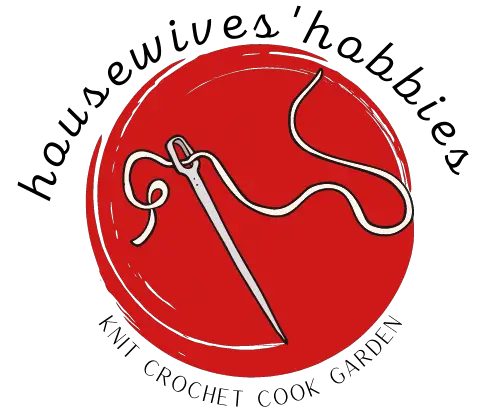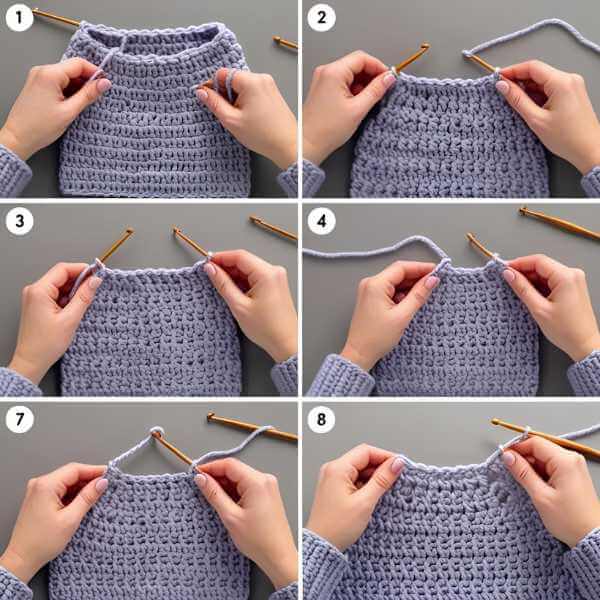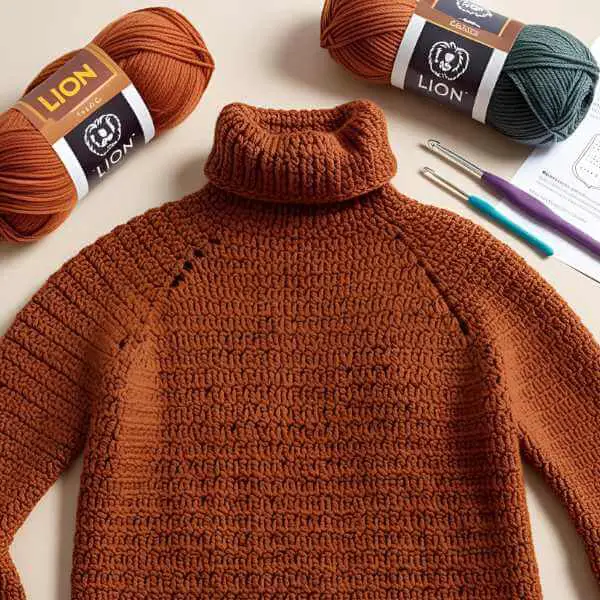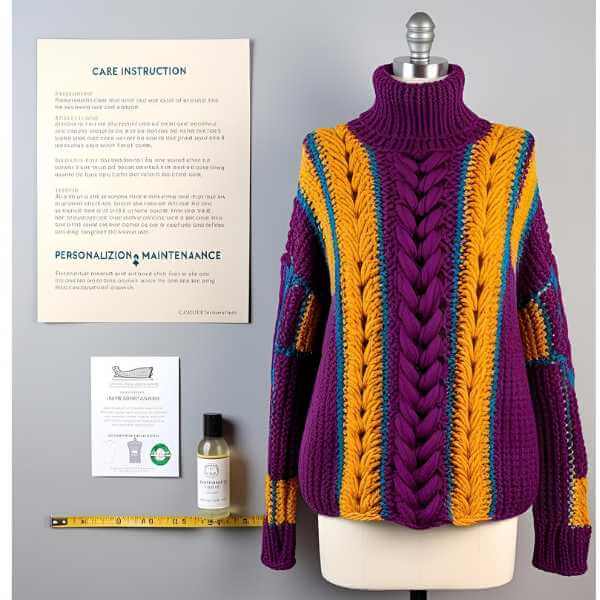Crochet turtleneck sweaters offer a delightful combination of style and comfort, making them perfect for chilly days. These crochet sweaters are not only stylish but also provide a cozy sweater option for your handmade wardrobe. Whether you are an experienced crocheter or a curious beginner, this guide provides all the information you need—from essential materials and yarn selection to step-by-step instructions for crafting your own masterpiece. The Fiddle Sweater, for instance, is an easy crochet project that’s beginner friendly and perfect for all body sizes. Additionally, it includes tips for customization, highlights common pitfalls to avoid, and offers guidance on how to care for your creation using affiliate links for recommended products. Explore various pattern variations to find the perfect fit. Get ready to embrace your creativity and stay warm!
Key Takeaways:
- Choose the right yarn, such as Lion Brand Yarn or Yarn Bee Soft & Sleek, and crochet hook size for your turtleneck sweater to ensure a perfect fit and comfortable wear.
- Follow step-by-step instructions and use tips and tricks to avoid common mistakes and create a beautiful turtleneck sweater using basic crochet techniques like single crochet and double crochet.
- Properly care for your crochet turtleneck sweater to maintain its quality and longevity. Explore various patterns to find the perfect one for your style and skill level.
What Is a Crochet Turtleneck Sweater?
A crochet turtleneck sweater is a stylish and versatile clothing item that combines warmth and comfort, making it an ideal addition to any handmade wardrobe. With its ribbed turtleneck and comfy sweater design, it’s perfect for various body types.
This cozy sweater can be crafted using various crochet techniques, such as single crochet and double crochet, and is often designed in vibrant autumn colors, such as pumpkin spice. The turtleneck cowl adds an extra layer of warmth and style.
A popular example is the Fiddle Sweater, known for its easy crochet pattern, which features an oversized fit and a ribbed turtleneck, adding both elegance and functionality to the design. It’s especially loved for its easy construction and vertical braid details.
What Materials Do You Need to Make a Crochet Turtleneck Sweater?
To create a crochet turtleneck sweater, you will need specific materials, including the appropriate type of yarn and tools, to achieve the desired fit and style.
- Yarn: Most beginner-friendly crochet turtleneck sweater patterns, such as the Fiddle Sweater, recommend using worsted weight yarn. Lion Brand Yarn is an excellent choice, offering a wide range of vibrant colors from the Color Theory collection by Two of Wands that would work well in a fall-inspired palette.
- Tools: You will also need crochet hooks and yarn needles to assemble the pieces of your project. Yarn needles are essential for ensuring that the pieces are sewn together neatly and securely, especially for sewing pieces with crochet ribbing or crochet cuffs.
What Yarn Should You Use?
When selecting yarn for a crochet turtleneck sweater, both the yarn weight and type are critical components to consider. A heavier worsted yarn is typically preferred for turtleneck sweaters as it provides the warmth and drape necessary for a comfortable fit. Acrylic yarn is the most common choice among crocheters due to its balance of cost and ease of care. Opting for acrylic yarn in fall colors creates an ideal medium for crafting vibrant designs.
Crocheters have a variety of fiber options, including cotton and wool blends, each offering unique textures and appearances. Fibers with a structured weave impart a crisper, more tailored look, while those with a finer weave result in a softer, more relaxed neckline. Warm, rich colors like burgundy and dark green can evoke a rustic winter aesthetic, whereas pastels can lend a light and airy springtime feel.
When selecting the color of the yarn, it’s important to consider the turtleneck’s height and fit around the neck. This ensures that when the turtleneck is folded down, the design and layering remain visually appealing. Crocheting a turtleneck sweater in a color that coordinates with high-end outerwear allows the wearer to feel both comfortable and stylish, even beneath a warm winter coat.
Suitable color combinations might include a charcoal or navy outer layer paired with a white or beige interior piece, which softens the turtleneck’s profile and provides a balanced, complete look. A turtleneck is often paired with a blazer or fitted jacket, so choosing a yarn that complements the design is essential for achieving the proper drape and fit.
The pattern should specify the recommended yarn type, weight, and gauge. Considering the softness of the yarn is also important, as a scratchy yarn may prove uncomfortable around the neck. Swatching is crucial to ensure the crocheter selects the right yarn for their project, as it provides a preview of the final piece. Testing the feel and function of yarns with different weights, materials, and structures will help achieve the desired cozy and stylish outcome.
What Size Crochet Hook Should You Use?
Selecting the right size crochet hook is essential for ensuring that the gauge measurement in your crochet turtleneck sweater project is accurate. The pattern notes typically specify the recommended hook size, as using the wrong size can result in stitches that are either too loose or too tight, affecting the fit of the sweater.
For many beginner crochet patterns for turtleneck sweaters, such as the Fiddle Sweater, using the correct hook size helps you avoid common crochet mistakes and create a well-fitting, stylish garment. Understanding how hook size influences stitch tension is crucial; larger hooks produce more relaxed, airy, and flexible stitches, while smaller hooks yield tighter and denser stitches. This variation can significantly impact the finished look and feel of the garment.
To achieve the best results, it is advisable to make gauge swatches with your chosen yarn before starting the actual project. These swatches will allow you to experiment with how your selected crochet hook interacts with the yarn’s weight and the pattern’s specifics, which is especially helpful for beginner crocheters.
Taking the time to swatch can save you both time and frustration in the long run.
How to Get Started with Your Crochet Turtleneck Sweater?
The first step to crocheting a turtleneck sweater is to select a suitable crochet pattern and familiarize yourself with the basic techniques required to complete it. Reading pattern notes carefully will assist in understanding the required crochet stitches.
Beginners are encouraged to choose a simple crochet pattern that provides clear instructions, allowing them to learn the steps sequentially.
While crochet patterns can vary in complexity, starting with an easy one will help you understand the process and build confidence as you create your cozy sweater.
How to Choose the Right Pattern?
When choosing the right crochet pattern for your turtleneck sweater, it is important to consider both your skill level and the desired style. Advanced beginners might enjoy patterns that include easy construction methods and easy crochet options.
Advanced beginners may prefer patterns that offer creative options while also providing essential notes to guide them through the project.
Along with style, you should evaluate the complexity of the pattern to ensure it aligns with your abilities. A simple, clear pattern can boost your confidence, especially if it includes options for personalization, allowing you to create a piece that reflects your personal touch.
Take the time to carefully read through the pattern notes to assess how easy they are to follow; patterns that are straightforward can enhance your crocheting experience. Striking a good balance between manageable tasks and opportunities for customization will inspire you to craft a unique piece that you will enjoy wearing.
How to Read a Crochet Pattern?
Understanding how to read a crochet pattern is crucial when making your turtleneck sweater, as it provides the specific techniques and instructions needed to create your individual pieces.
The first step is to familiarize yourself with the pattern notes, which typically include important information on gauge measurement—indicating how tight or loose your stitches should be—along with the types of stitches and any special techniques that will be used throughout the pattern.
This knowledge is essential for following the instructions accurately and making adjustments as necessary.
While it may seem daunting at first, especially for beginners, learning the abbreviations used in crochet patterns will come with practice. Familiarizing yourself with the shorthand (for example, ‘ch’ for chain and ‘sc’ for single crochet) is a necessary step to understanding how to read a crochet pattern.
Stitch counts are another key component of crochet patterns, serving as checkpoints throughout the project. Keeping track of stitch counts ensures that each section is completed correctly.
A helpful tip for beginners is to read through the entire pattern before picking up your crochet hook. This practice allows you to familiarize yourself with what to expect, minimizing misunderstandings and helping you visualize the finished product.
With patience and practice, reading crochet patterns will become second nature.
Step-by-Step Instructions for Crocheting a Turtleneck Sweater
Crocheting a turtleneck sweater can be an enjoyable and rewarding crochet project, especially when you follow simple step-by-step instructions.
Utilizing basic crochet skills and construction techniques will make it easy for you to create a warm sweater.
Whether you’re making a Fiddle Sweater or a similar design, working on the project in sections will make the process easier and more gratifying.
1. Start with the Neckline
Begin with the neckline, as it is the first step in crocheting a turtleneck sweater. The crochet ribbing around the neckline is a crucial element of the sweater, serving as the foundation for the torso and sleeves.
A ribbed neckline offers comfort and stretch, allowing the sweater to fit snugly without being overly tight. As you work on this step, pay close attention to your gauge measurement to ensure that the neck maintains its shape and fits well with the rest of the garment.
To create a well-defined neckline, consider using additional stitches that not only enhance visual interest but also improve flexibility. The ribbing is formed by alternating between front and back post double crochets, which adds texture and helps secure the neckline.
If any adjustments are needed, changing the number of stitches or rows is often sufficient to achieve a better fit for most necks. You can also incorporate color changes or different stitches for personalization, allowing the final product to reflect your unique style.
Remember to test the fit as you progress to ensure satisfaction with the finished piece.
2. Work on the Body of the Sweater
The body of the sweater is the perfect opportunity to showcase your crochet skills using various techniques after completing the neckline. You can utilize basic crochet stitches, such as single crochet and double crochet, to create a textured body that fits comfortably while still maintaining an oversized look.
Incorporating a vertical braid can enhance the aesthetic and visual appeal of the design.
To achieve the desired oversized fit without losing shape, it’s essential to pay special attention to stitch count and overall dimensions. Begin by measuring your bust size and adding extra stitches to allow for additional room, ensuring that the increase is gradual at the sides. The shape should conform to your body without being overly tight.
A good rule of thumb is to choose a size that is 4-6 inches larger than your bust size. This will help ensure that the sweater drapes naturally and does not cling.
Experimenting with different stitch patterns, such as alternating clusters and shells, can further enhance the texture of the body. Additionally, decorative elements like tassels or lace trim can elevate the style of the sweater.
3. Create the Sleeves
The sleeves of your crochet turtleneck sweater play a crucial role in its overall construction, providing both comfort and style. You can choose between a fitted sleeve or a more relaxed style, depending on the desired fit of the sweater, ensuring that the sleeves match the body size you have selected.
To finish the sleeves and achieve a neat appearance, use a yarn needle to sew the cuffs on evenly.
To begin crocheting the sleeves, first determine the length and width that will best complement your design. Measure the arm circumference and the desired sleeve length for the wearer.
Using the foundational chain of your chosen stitch, crochet in rounds or rows as required, adjusting the number of stitches as necessary to shape the sleeves appropriately.
When creating the cuffs, consider using a pattern that mirrors the ribbing or texture of the body of the sweater for consistency. Once you have completed both the sleeves and cuffs, lay them flat before sewing to ensure they are even.
This allows you to make any necessary adjustments for a tidy finish and an appealing overall appearance of the sweater.
4. Finish with the Turtleneck
Completing the turtleneck section of your sweater is the final and most enjoyable step of your crochet project. During this phase, you can apply simple construction techniques to create a ribbed turtleneck that fits snugly and enhances the overall style of your garment.
It is important to keep the gauge measurement in mind to ensure that the turtleneck is neither too tight nor too loose. By using a combination of front post and back post double crochet stitches, you can achieve ribbing that adds textured contrast to the design.
Additionally, planning the length of the turtleneck in advance is essential, as preferences can vary; some may prefer a longer fold-over, while others may opt for a shorter style. Measurements can be taken while crocheting to accommodate any necessary adjustments.
Finally, weaving in ends and blocking the turtleneck are crucial, yet often overlooked, steps. These actions can significantly enhance the appearance and feel of the finished sweater, ensuring it looks neat and professional.
Tips and Tricks for Crocheting a Perfect Turtleneck Sweater
Tips and tricks for crocheting the perfect turtleneck sweater can assist both advanced beginners and experienced crocheters in creating a high-quality product.
By understanding the nuances of crochet techniques and recognizing how they differ from one pattern to another, you can ensure that your warm sweater turns out just as you envision it.
How to Adjust the Size of Your Sweater?
To size a crochet turtleneck sweater, follow the gauge measurement provided in your crochet pattern. This measurement will help you adjust the width and length of the sweater to fit different dimensions, enabling you to create a custom-sized garment that suits your body type and provides comfort and confidence.
Understanding how to modify the stitch count and row increments is essential for tailoring the piece to your measurements. For example, if you find the body width is becoming too tight, you can add a few stitches on each side while maintaining the same ratio of row increments.
It’s crucial to use proper measurement points, such as the bust and hips, to guide your adjustments on how many stitches or rows to add. Additionally, trying on the piece as you make adjustments will ensure that you are sizing it appropriately and achieving a flattering shape.
How to Add Embellishments to Your Sweater?
Adding embellishments to your crochet turtleneck sweater is a wonderful way to personalize the garment and express your unique style. You can apply decorative stitches, fun appliqués, and various crochet techniques to create beautiful details that enhance your project.
These embellishments can be tailored to different pattern variations, depending on how you believe they will positively impact the appearance of your crocheted turtleneck. For instance, lining the collar or hemline with crocheted flowers can add a fresh and feminine touch to the neckline. Additionally, decorative buttons can transform a basic design into something striking, as can thoughtfully placed borders around the garment.
Before selecting these details, be sure to consider the color scheme and stitch patterns you have chosen for the main structure of the garment to ensure they harmonize with the overall design.
Common Mistakes to Avoid When Crocheting a Turtleneck Sweater
Common mistakes when crocheting a turtleneck sweater include several key factors:
- Failing to take gauge measurements
- Using the wrong type of yarn
- Ignoring pattern instructions
- Neglecting tension
- Rushing through the project
Beginner crocheters often encounter fitting issues and uneven stitches because they overlook the importance of taking gauge measurements.
By being aware of these common pitfalls, you can consciously avoid them and enhance your chances of creating a successful project.
How to Care for Your Crochet Turtleneck Sweater?
Caring for your crochet turtleneck sweater is essential for preserving its longevity and quality. The washing and drying instructions can vary depending on the type of yarn used, so it’s important to follow the correct guidelines to avoid damaging the garment’s shape and texture.
By regularly caring for your crochet turtleneck sweater, you will not only maintain the appearance of your handmade wardrobe but also extend the life of the garment.
Where to Find More Crochet Turtleneck Sweater Patterns?
If you’re looking for more crochet turtleneck sweater patterns, numerous websites, blogs, and online crochet communities offer inspiration, including the Fiddle Sweater, along with instructions for many other popular designs.
Some of these resources feature affiliate links that allow you to purchase materials from yarn suppliers.
Frequently Asked Questions
What is a Crochet Turtleneck Sweater Pattern?
A Crochet Turtleneck Sweater Pattern is a set of instructions that guide you through the process of creating a turtleneck sweater using crochet techniques.
What materials do I need to make a Crochet Turtleneck Sweater Pattern?
You will need yarn, a crochet hook, and a tapestry needle to make a Crochet Turtleneck Sweater Pattern. You may also need scissors, stitch markers, and other helpful tools depending on the specific pattern.
Can I customize the size of the Crochet Turtleneck Sweater?
Yes, most Crochet Turtleneck Sweater Patterns include instructions for multiple sizes, so you can choose the size that best fits you or the person you are making the sweater for.
Is this pattern suitable for beginners?
Some Crochet Turtleneck Sweater Patterns may be suitable for beginners, while others may require more advanced crochet skills. Make sure to read the difficulty level and any special techniques required before starting a pattern.
Can I sell items made from this Crochet Turtleneck Sweater Pattern?
It depends on the specific pattern and the designer’s terms. Some patterns may allow you to sell finished items, while others may have restrictions. Make sure to check the pattern’s details before selling any items made from it.
Where can I find Crochet Turtleneck Sweater Patterns?
Crochet Turtleneck Sweater Patterns can be found in craft stores, online marketplaces, and on individual designers’ websites. You can also find free patterns on blogs and social media platforms.





